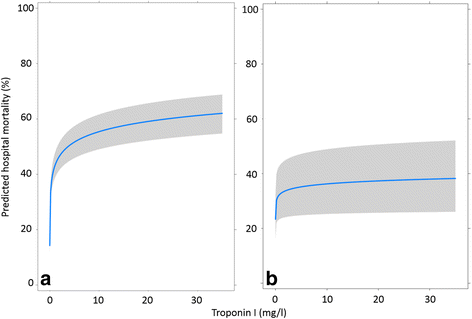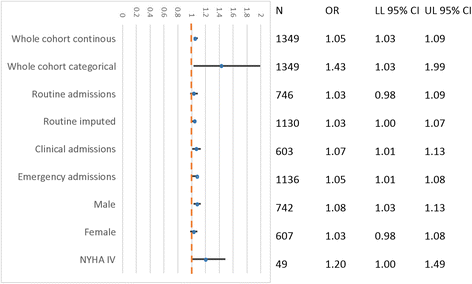Early troponin I in critical illness and its association with hospital mortality: a cohort study
- PMID: 28814347
- PMCID: PMC5559840
- DOI: 10.1186/s13054-017-1800-4
Early troponin I in critical illness and its association with hospital mortality: a cohort study
Abstract
Background: Troponin I (TnI) is frequently elevated in critical illness, but its interpretation is unclear. Our primary objectives in this study were to evaluate whether TnI is associated with hospital mortality and if this association persists after adjusting for potential confounders. We also aimed to ascertain whether addition of TnI to the Acute Physiological and Chronic Health Evaluation II (APACHE II) risk prediction model improves its performance in general intensive care unit (ICU) populations.
Methods: We performed an observational cohort study with independent derivation and validation cohorts in two general level 3 ICU departments in the United Kingdom. The derivation cohort was a 4.5-year cohort (2010-2014) of general ICU index admissions (n = 1349). The validation cohort was used for secondary analysis of a prospective study dataset (2010) (n = 145). The primary exposure was plasma TnI concentration taken within 24 h of ICU admission. The primary outcome was hospital mortality. We performed multivariate regression, adjusting for components of the APACHE II model. We derived the risk prediction score from the multivariable model with TnI.
Results: Hospital mortality was 37.3% (n = 242) for patients with detectable TnI, compared with 14.6% (n = 102) for patients without detectable TnI. There was a significant univariate association between TnI and hospital mortality (OR per doubling TnI 1.16, 95% CI 1.13-1.20, p < 0.001). This persisted after adjustment for APACHE II model components (TnI OR 1.05, 95% CI 1.01-1.09, p = 0.003). TnI correlated most strongly with the acute physiology score (APS) component of APACHE II (r = 0.39). Addition of TnI to the APACHE II model did not improve discrimination (APACHE II concordance statistic [c-index] 0.835, 95% CI 0.811-0.858; APACHE II + TnI c-index 0.837, 95% CI 0.813-0.860; p = 0.330) or other measures of model performance.
Conclusions: TnI is an independent predictor of hospital mortality and correlates most highly with the APS component of APACHE II. It does not improve risk prediction. We would not advocate the adoption of routine troponin analysis on admission to ICU, and we recommend that troponin be measured only if clinically indicated.
Keywords: Critical care; Hospital mortality; Troponin.
Conflict of interest statement
Ethics approval and consent to participate
All data were anonymised prior to release to the researchers, and therefore an ethics waiver was granted by the local research ethics committee (West of Scotland Research Ethics Service, 06/09/15), and approvals from NHS Greater Glasgow and Clyde Caldicott Guardian (04/06/15) and SICSAG (06/05/15) were obtained.
Consent for publication
All data were anonymised prior to release to the researchers, and therefore an ethics waiver for consent was granted by the local research ethics committee.
Competing interests
The authors declare that they have no competing interests.
Publisher’s Note
Springer Nature remains neutral with regard to jurisdictional claims in published maps and institutional affiliations.
Figures




Comment in
-
Improving risk stratification for hospital mortality using troponin: is it time for a change of heart?J Lab Precis Med. 2018 Jan;3:6. doi: 10.21037/jlpm.2018.01.04. Epub 2018 Jan 23. J Lab Precis Med. 2018. PMID: 30234190 Free PMC article. No abstract available.
References
-
- Ostermann M, Lo J, Toolan M, Tuddenham E, Sanderson B, Lei K, et al. A prospective study of the impact of serial troponin measurements on the diagnosis of myocardial infarction and hospital and six-month mortality in patients admitted to ICU with non-cardiac diagnoses. Crit Care. 2014;18(2):R62. doi: 10.1186/cc13818. - DOI - PMC - PubMed
Publication types
MeSH terms
Substances
LinkOut - more resources
Full Text Sources
Other Literature Sources
Miscellaneous

